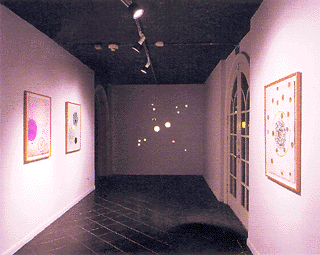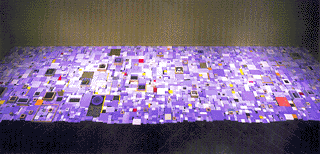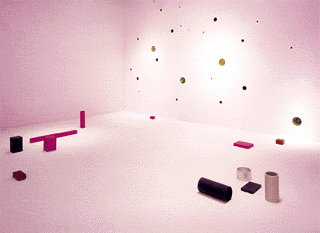https://www.austinchronicle.com/arts/1998-08-21/523797/
Sacred Spaces and the Art of Margo Sawyer at AMOA
By Rebecca S. Cohen, August 21, 1998, Arts
|
|
Occasionally, an art exhibition engages me in an intensely personal conversation. It happened recently with "Margo Sawyer: Presence and Absence" at the Austin Museum of Art – Laguna Gloria. This is the museum's second Art in Process exhibition, showcasing a local artist's work in the downstairs galleries while providing a Web page, an e-mail address, and a studio for the artist in the upstairs gallery. A far cry from the traveling exhibitions and corporate art exhibited this year at 823 Congress, Art in Process is one of the most innovative programs the museum has offered Austin in recent memory. Through exchanges on the Internet and in the studio, the public can experience comfortable and sustained access to the artist and gain insight into his or her process. You can ask all the questions you want.
Last year, Sydney Yeager was pleased to interact with people who came to the museum to see her paintings. She also enjoyed using the computer provided in her studio to field questions and comments via the electronic "message board." This year, Sawyer is equally accessible. Her work, however, offers a greater challenge. The Associate Professor in Sculpture and Assistant Chair of Studio Art at UT Austin is represented in the downstairs galleries by a number of modest-sized works on paper and two large installations. Children "get it" right away, according to Julia Hart, who works with the museum's docent program. Maybe this is because one of the installations is built out of blocks and the other offers definite advantages for the tiny and/or flexible body. But adults have a harder time making sense of Sawyer's work.
Blue, the installation which occupies the first room, is composed of small blocks painted various shades of blue and yellow and ochre. There are touches of red, but overall the pattern is muted, nearly monochromatic. The wooden surfaces show evidence of individual brush strokes, personal attention. Sawyer has carefully positioned the various elements on the floor next to painted gold walls. They extend outward in a not quite straight line so that half the floor is covered. True to the notion of installation art, the familiar gallery is totally transformed; the viewer (no matter how small) becomes a lumbering giant surveying a sprawling city sleeping at dusk. Or perhaps visitors are in the presence of a river as Mondrian might have painted it. Or maybe, as one younger viewer noted, it is really the sky that we're looking down on, and the world has turned upside down.
The artist is intent on "articulating space and material to induce intimate expressions of spiritual elevation and emotional intensity." Written more simply, Sawyer attempts to evoke a sense of sacred space. She has visited sacred places throughout the world and spent over a year in India and a similar length of time in Japan, courtesy of Fulbright Research Grants in 1982-83 and 1995-96, respectively. Eastern temples and gardens, along with Egyptian pyramids and American canyons, have shaped her vision. Being raised as an atheist may have contributed as well to the artist's quest to find and create transcendent spaces. She uses line, form, and color in place of Judeo-Christian liturgy or Buddhist ritual to encourage individuals to find inner peace. One visitor claims that Sawyer's work led her to do something that organized religion had yet to accomplish. "It brought me to my knees!" she said. The same thing happened to me.
|
|
For the second installation, called "Presence and Absence," the artist has created a brightly lighted room in the back gallery to which visitors have visual access only by peering through peepholes. The holes punctuate two Sheetrock walls at various (and from all appearances arbitrary) positions, each opening lined with metal tubing or cones. Each hole offers a unique perspective on that mysterious space we know exists but cannot enter. (Hint: The most complex views are to be found by peering through the holes nearer the bottom of the wall.) If you don't want to bend and stretch, strain and squint to see each of these circular visions, you can simply stand back and wonder at the glowing puncture marks in two narrow, dark corridors to nowhere. It's up to you.
During my second visit to the gallery, I hunkered down and checked out every peephole as if peering through a construction fence. And as I made the effort, I had an Art Critic Epiphany. The experience of Presence and Absence is a metaphor for how people look at art. Some of us (and I include myself on the occasions when I smugly assume that I know all there is to know about an artist's work) glance at art from a distance and have a correspondingly distant experience. Oh yeah, a landscape painting. Others get closer and peer through a peephole or two. Oh yeah, a landscape painting created with thick brush strokes loaded with paint. Still others bend and stretch to experience an object or an installation to the fullest. Oh yeah! A landscape painting where the manipulation of paint and choice of colors reflects how the artist felt rather than what she actually saw. In exchange for our time and attention, individual works reveal secrets that the casual observer will never discern. (Hint #2: There is no paint-laden landscape hiding behind Sawyer's peepholes.)
Sawyer, who speaks with a delightful British accent, did not disagree with my metaphor, although she was much more interested in talking about the way her art, like sacred architecture, attempts to evoke a meditative and contemplative state. And that was where my personal conversation with the exhibition really began.
I've been thinking a lot lately about sacred spaces, having become involved in our synagogue's process to design and construct a new building. Is there a recipe for the creation of a space where people will come together to pray? Can an artist or an architect (in the case of my congregation, David Lake of Lake/Flato Architects in San Antonio) really be expected to create sacred space? In an informal discussion in Sawyer's museum studio in June, Michael Bendikt, Professor of Architecture and Director of the Center for American Architecture and Design at UT, said "no." Perhaps acting as provocateur, he took the position that space becomes sacred only after a long history of miraculous occurrences within that space. (Although earlier in the discussion, he conceded that the realization of art or architecture from concept to completion is a kind of miracle in itself.)
In any event, it is probably true that artists and architects cannot create sacred space. But they can reference cultural memories of times and places where transcendent events have occurred as they've done in European cathedrals lined with murals depicting Biblical stories, in Buddhist temples where candlelight flickers against carved jade statues. The reasonable goal of art and architecture is to free the mind, stir the imagination, transport us away from the quotidian. Organized religions encourage us to travel a certain path by telling stories. In the temples of fine art (particularly contemporary art), the mind is free to travel wherever it wants to go.

During her own travels, Margo Sawyer took note of "how physical spaces articulate intimate expressions of ritual and spiritual transcendence," but her work also deals with the ephemeral nature of such experiences. Her installations, by definition, are temporary, transitory. And yet many of the components she uses find new life in future installations. The ideas that she employs also evolve and are reborn in both artist and viewer. I like to think about the appearance of elements from Elysian Fields – an installation that Sawyer created for the Sagacho Exhibit Space in Japan – in Blue here at AMOA in Austin. I want to know how Sawyer will dismantle the walls that she's built for Presence and Absence and whether she will salvage the metal tubes and reuse them in another installation. Installations welcome playful questions and imagination. They encourage it. Children understand the opportunity immediately: "Let's pretend we are looking through telescopes to a galaxy far away!" Grownups, regrettably, find it difficult to "collaborate" with the artist, to shake loose what they think they already know.
Marcel Duchamp, an artist working earlier in this century, suggested that it is the viewer who completes a work of art. If he is correct, Sawyer's installations depend not only on the artist's ideas, craft, and impressive credentials (which are detailed in a small, four-color catalogue with an essay by Dana Friis-Hansen, Senior Curator of Houston's Contemporary Art Museum), but also on the attitudes and ideas that we bring to the museum. Sacred spaces (including the one that Lake/Flato is designing for our congregation) must be "activated" by people who are seeking or, at the very least, are open to achieving a meditative state. Consider a pilgrimage, then, to the local art museum. Let your mind soar.
"Margo Sawyer: Presence and Absence" is on view through August 30 at the Austin Museum of Art – Laguna Gloria, 3809 W. 35th. Call 454-8191 for info.
Copyright © 2025 Austin Chronicle Corporation. All rights reserved.


